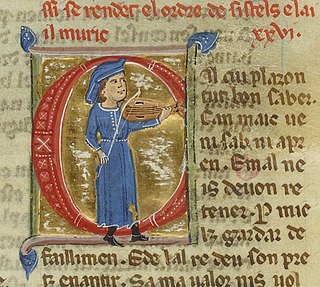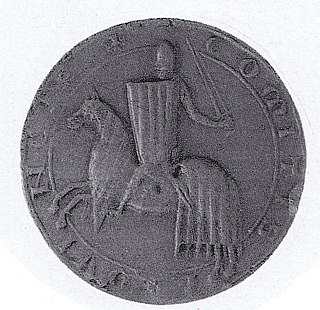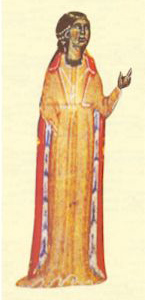
A troubadour was a composer and performer of Old Occitan lyric poetry during the High Middle Ages (1100–1350). Since the word troubadour is etymologically masculine, a female troubadour is usually called a trobairitz.
Occitan literature is a body of texts written in Occitan, mostly in the south of France. It was the first literature in a Romance language and inspired the rise of vernacular literature throughout medieval Europe. Occitan literature's Golden Age was in the 12th century, when a rich and complex body of lyrical poetry was produced by troubadours writing in Old Occitan, which still survives to this day. Although Catalan is considered by some a variety of Occitan, this article will not deal with Catalan literature, which started diverging from its Southern French counterpart in the late 13th century.

Ramon Berenguer IV was a member of the House of Barcelona who ruled as count of Provence and Forcalquier. He was the first count of Provence to live in the county in more than one hundred years. During the minority of a previous count, the regency was exercised by Ramon Berenguer IV de Barcelona, who is sometimes counted among the counts of Provence. It follows that the count Ramon Berenguer IV de Provence is often named Ramon Berenguer V de Provence.

The trobairitz were Occitan female troubadours of the 12th and 13th centuries, active from around 1170 to approximately 1260. Trobairitz is both singular and plural.
Aimeric or Aymeric or Aimery is a male given name:
The canso or canson or canzo was a song style used by the troubadours. It was, by far, the most common genre used, especially by early troubadours, and only in the second half of the 13th century was its dominance challenged by a growing number of poets writing coblas esparsas.

Perdigon or Perdigo was a troubadour from Lespéron in the Gévaudan. Fourteen of his works survive, including three cansos with melodies. He was respected and admired by contemporaries, judging by the widespread inclusion of his work in chansonniers and in citations by other troubadours.
Formit de Perpinyà or Perpegnan was a Catalan troubadour from Perpignan in the Roussillon, possibly living in the thirteenth century. His name, Formit, rare for the time, means "satisfied, perfect, ready" and was probably a nickname. Only one canso survives to his name, preserved in only one chansonnier. It comprises four coblas unissonans. Its first line begins Un dolz dezirs amorous and it is metrically, but not rhymewise, identical to A vos, bona don'e pros which is attributed by some manuscripts to Raimbaut de Vaqueiras and by others left unattributed, leading subsequent scholars to suggest that it was the work of either Aimeric de Pegulhan or Formit.

Aimeric de Belenoi was a Gascon troubadour. At least fifteen of his songs survived. Seven others were attributed to him in some medieval manuscripts.

Azzo VI, also known as Azzolino, was an Italian nobleman and condottiero. He held the title of Marquis of Este from the death of his father, Azzo V (1190) until his death.

Nicoletto da Torino was a Piedmontese jongleur and troubadour of the first half of the thirteenth century, probably from Turin, though some believe that to be his father's name. He produced three surviving tensos with Joan d'Albusson, Falquet de Romans, and Uc de Saint Circ.
Paolo Lanfranchi da Pistoia was a noted Italian poet who wrote in both the Italian and Occitan languages. He is thus sometimes described as a troubadour. A native of Pistoia—he was a major cultural figure of the Duecento there—his sonnets have been praised for their originality.
Simon Doria was a Genoese statesman and man of letters, of the important Doria family. As a troubadour he wrote six surviving tensos, four with Lanfranc Cigala, one incomplete with Jacme Grils, and another with a certain Alberto. He was the son of a Perceval Doria, but not the Perceval Doria who was also a troubadour and probably his cousin.

Peire Guilhem de Luserna was a Piedmontese troubadour.

Ferrari da Ferrara, fully Ferrarino (dei) Trogni da Ferrara, was a troubadour of Ferrara in the late 13th and early 14th centuries. He was a composer, anthologist, and possibly autobiographer. He was one of the last active troubadours in Italy.
Uc de Lescura or de l'Escura was a minor troubadour. The Lescura of his birth is unknown. There is a Lescurre in Ariège, Aveyron, and Tarn. Based on references in his work, historian Alfred Adler placed him at the court of Alfonso VIII of Castile and in Catalonia.
Bertran Folcon d'Avignon or Bertran Folco d'Avinhon was a Provençal nobleman and troubadour from Avignon. He was a faithful partisan of Raymond VI and Raymond VII of Toulouse in Provence, and participated in the wars against the Albigensian Crusade. He was inside the city during the siege of Beaucaire in 1216. In 1226 Raymond VII appointed him bailiff of Avignon.
Isnart or Iznart d'Entrevenas or d'Antravenas was a Provençal troubadour, the son of Raimon d'Agout, a patron of troubadours, and husband of Beatrice, daughter of Jaufre Reforzat de Trets.

Matfre Ermengau was a Franciscan friar, legist, and troubadour from Béziers. He had a master of laws degree.
Bernart de Bondeills was a 13th-century Occitan troubadour known from only one composition, the canso Tot aissi·m pren com fai als Assesis, found in chansonnier M, BnF Paris, f.f. 12474. Although originally from the Auvergne, he worked at the court of the north Italian nobleman Ottone del Carretto, a prolific patron of troubadours.